WorldShare Acquisitions Release Notes, February 2023
Release Date: February 2, 2023
Introduction
This release of WorldShare Acquisitions provides 5 new features and enhancements in addition to numerous bug fixes. These features will help you manage more complex workflows, including:
- Disabling a fund for all uses
- Transfer details for budgeted amount history
- Changing the resource for multiple one-time order items
- Improved secondary matching process for print books
- Increased number of rows on budget page
Many of these enhancements are the direct result of your feedback.
Recommended actions
For this release, we recommend that you review the following checklists and complete the relevant tasks so that you can adjust your policies and workflows and train your staff. These checklists identify updates that we have determined as significant for most institutions. We encourage you to review all of the items in the release notes to determine whether there are other items that might require additional action or follow-up by your institution.
Administrative actions
These items require immediate action or decisions.
| Action |
|---|
|
None at this time. |
Follow-up actions
In an effort to keep your staff informed of new features and changes, you may also want to consider these items.
| Action |
|---|
|
Consider changing procedures to disable funds for all uses, rather than for new transactions only. |
| Consider changing procedures when changing resource to change all one-time order items with that resource. |
New features and enhancements
Disable a fund for all uses
You can now disable a fund for all uses, rather than just new transactions. This saves you the time and effort of instructing staff not to use this fund. Instead, this fund will simply not be selectable for any order items or invoice items. You can only disable items for all uses that are already not in active use (see further details below). You can use this feature to disable funds that are completely expended and have no remaining balance. You can also use this feature for "container" funds that should never be actually selected but rather serve as a way of grouping child funds. Previously, you could disable funds for new transactions, but you could not disable a fund for all uses. Now you can, and it should support a number of different uses.
To disable a fund for all uses:
- Open the budget in question using the budget dropdown in the left-hand menu under Budgets.
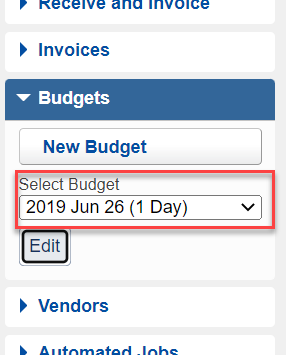
- Find the fund you want to disable.
- Click on the ellipsis ("...") in the action column in the far right-hand column.
- Select Edit from the menu.
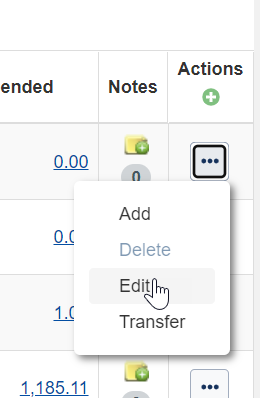
- In the Edit Dialog, select Disabled for All Uses from the Fund Status dropdown.

- If you want to apply this change to all child funds too, select the Apply Fund Status to Child Funds checkbox.
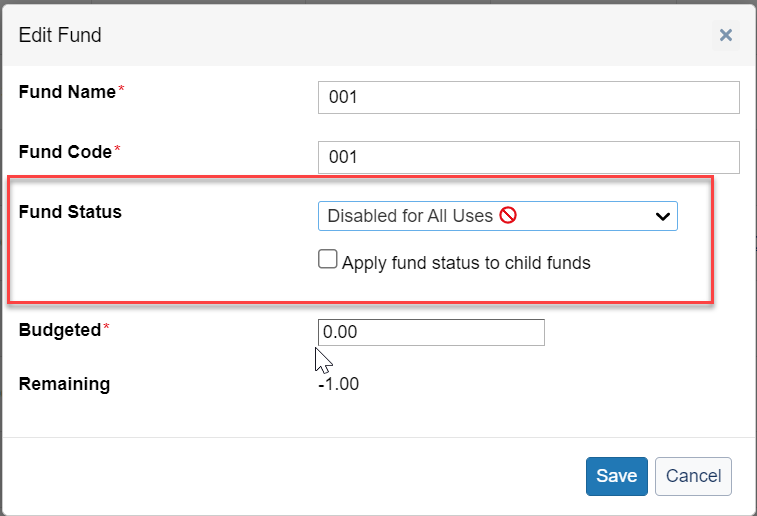
- Save the fund.
- You will receive an error message and not be able to save the fund if the fund has any of the following:
- Open order items
- Unpaid (open, ready, awaiting payment) invoice items.
- Unpaid or partially paid order items (This includes items that are invoiced, but the invoice is not paid as well as items that have not been invoiced or have been partially invoiced.)
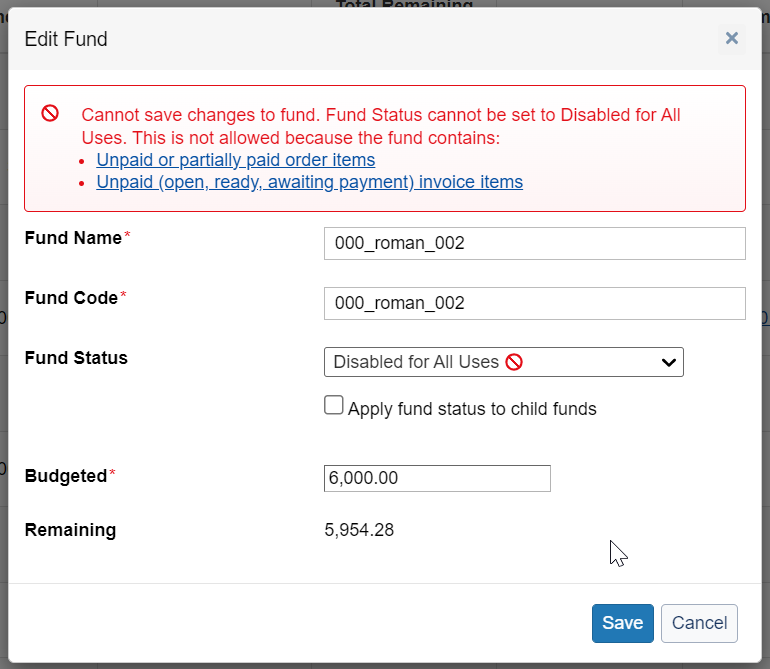
- This is because these items will result in a change to the fund's encumbrance or expenditure when they are modified (e.g. order is placed, order item is invoiced and paid, invoice is paid.)
- If successful, the fund will be disabled for all uses, and you will not be able to select this fund for order items or invoice items. The fund will show up in gray text and not be selectable.
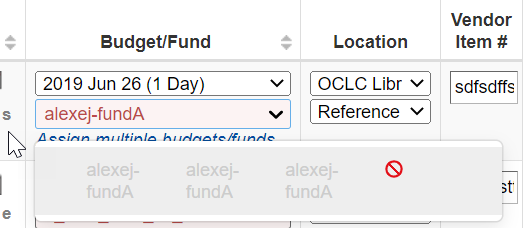
Transfer details for budgeted amount history
You can now view the details of a fund transfer on a budget. This saves you the time and effort of making notes on the funds when a transfer is made. Now you can simply view the details of the transfer in the budgeted amount history. Previously, you had to make notes on the fund if you wanted the details of a fund transfer, but now, you can simply view the transfer details in the budgeted amount history.
To view the details of a transfer:
- On the budget page, click the Budgeted Amount for the fund you want to view the transfer details for.
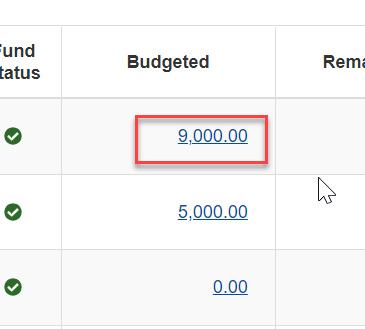
- This will open the budgeted amount history. If the budgeted amount has been changed via a transfer, the word transfer will appear as a link in the Type of Operation column.

- Click this link for the transfer you want to view.
- The Transfer Details dialog will appear with :
- The source fund at the top, including Fund Name, Fund Code, Change to Budgeted Amount, New Budgeted Amount
- The target funds, at the bottom, including Fund Name, Fund Code, Change to Budgeted Amount, New Budgeted Amount
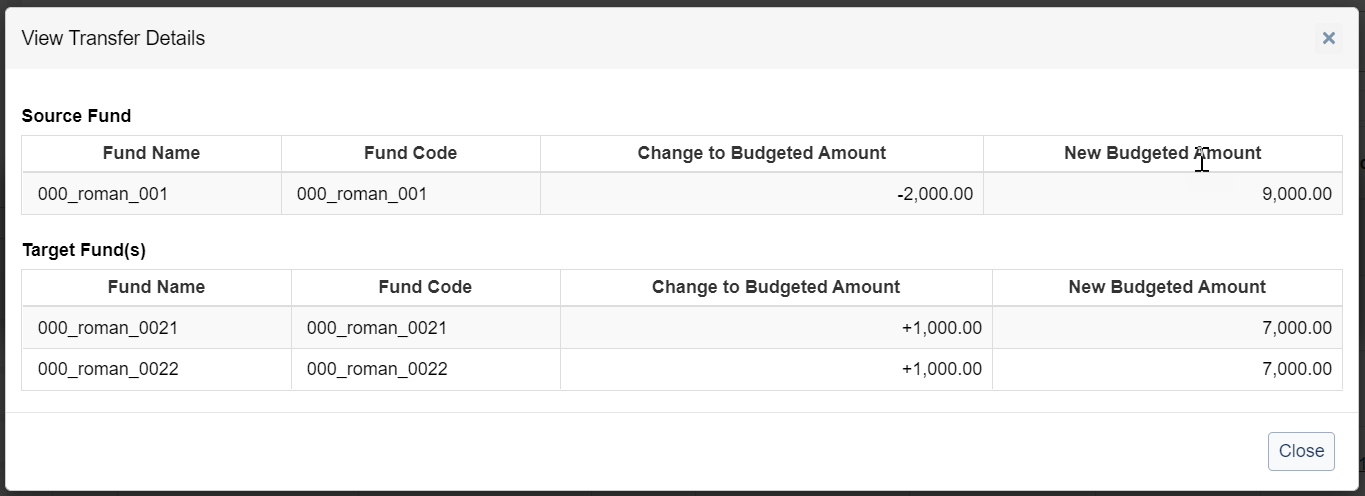
Change resource for multiple one-time order items
You can now change the resource of multiple one-time order items at the same time. This saves you time and effort of changing the resource for multiple one-time order items with the same (wrong) resource. For example, you may have imported a MARC order file with multiple items with the same resource (perhaps for different branches). You need to change the resource for these items because there is a more preferred record in WorldCat for the items in question. Previously, you had to open each item and change the resource for each one individually. Now, when you change the resource for one of the items, it will offer you the option to change the resource for all other one-time items that have the same resource.
To change the resource for multiple one-time order items:
- Open the order item details screen for the order item you want to change the resource for. (Orders > Order Items > Click on title.)
- Hover over the information icon at the top of the General Tab.
- Click change resource for the item.

- Search for the new resource you want to use in Discover Items or Discover Collections.
- Click on the title of the new resource you want to use.
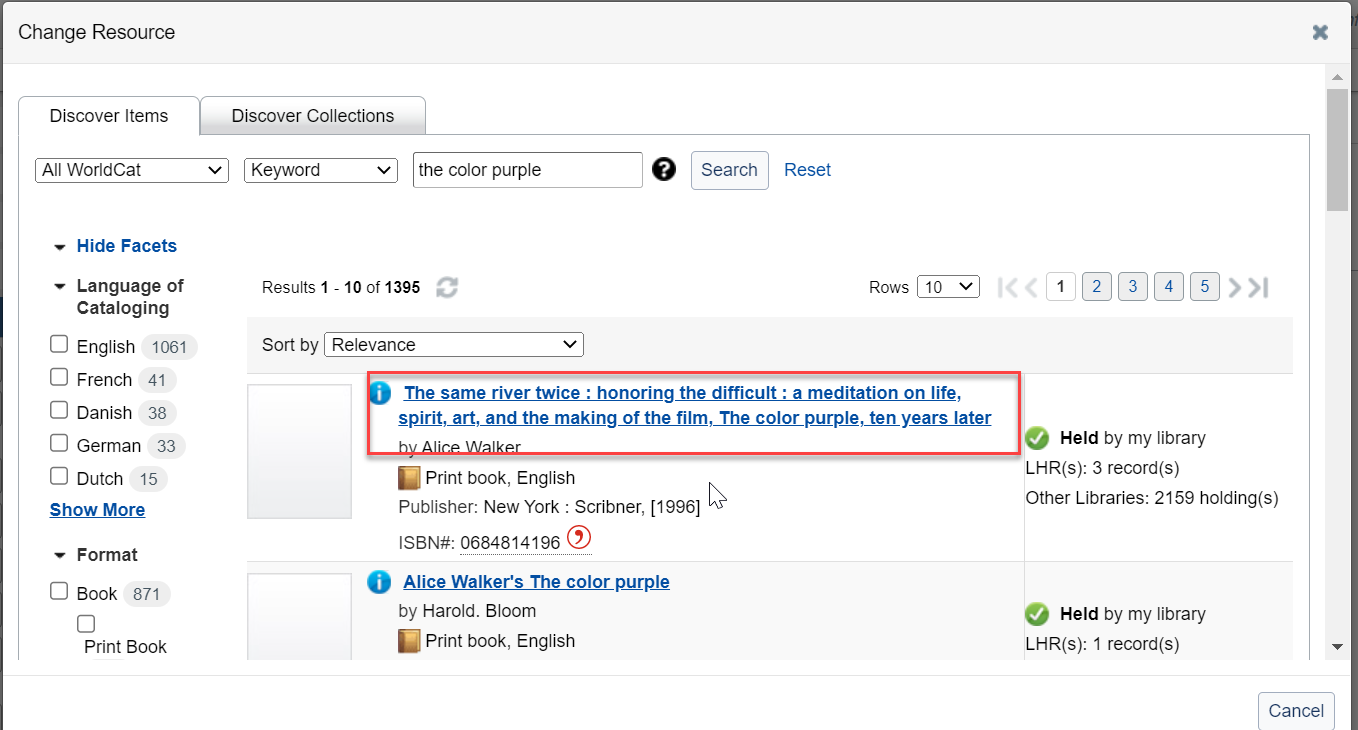
- A confirmation dialog will appear asking if you really want to change the resource.
- At the bottom of this dialog will be a checkbox that allows you to apply this change to all other one-time order items with this same resource. Checking this box and saving will apply this new resource to all the one-time order items with this resource as well as the Acquisitions Type, Processing Type, and Resource Requires Review setting selected in the dialog.

- If you select the checkbox, you will also be presented with the option to exclude received and partially received items from this change. This option is selected by default.
- Click change and the resource for this order item and all applicable order items will also change, saving you the time of having to do this for all order items.
Improved secondary matching process for print books
You can now match print book records in the MARC order import to the print book record in WorldCat when using the secondary matching process. When importing MARC order data that does not contain OCLC Numbers, the system will attempt to match these to a WorldCat record. The primary matching process takes into account the material type of the record and attempts to find a record with a matching material type. However, if the primary matching process fails to find a match, the secondary matching process kicks in (if you have selected the "include low-confidence matches" option when importing). This secondary matching process took into account material type for ebooks, but for print books would sometimes select the electronic book record by mistake. Now, the secondary matching algorithm should correctly select the print book record based on the value of the Leader/06 and 008 Form fields. Specifically, if the Leader/06 is set to "a" (for language material) but the 008 form field is not specifically set to a value that indicates an electronic material ("s" or "o"), microform, or other material, the system assumes the material is a print book and filters out possible matches that are not print books. This saves you the time and effort of changing the resource for print book items that are incorrectly matched to ebook records.
To use this improved secondary matching process:
- Open the vendor that you want to import the order data for.
- Click on Partner Exchange Services.
- Click on Upload.
- In the resulting dialog, select Type: Import order data (MARC) and select the option "Include low-confidence matches."

- Select and upload the file.
- The file will attempt to match the records to WorldCat using the primary matching process first, which already takes into account print book material types. Then, it will use the secondary matching process which now also filters records to only print books in specific cases.
Increased number of rows for the fund table
You can now set the number of funds to display on the budget page to 200 or 500 instead of just 100. This allows you to view most or all of your funds on the same page. Previously, the maximum number of funds that could be displayed was 100. Now, you can set it to up to 500.
To change the number of rows on the budget/fund table:
- Open a budget.
- In the top right of the funds table, select the number of rows you want to display.
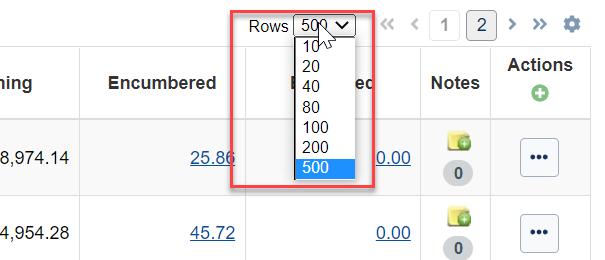
- As soon as you select it, the number of rows are displayed
Note: When you download funds on a budget in CSV, it always downloads all of the funds on your budget, not just the current page.
Bug fixes
Create new fund for new budget (with no funds)
You can now create a new fund for a new budget without any existing funds as well as existing budgets. Previously, this process was broken and would not allow you to create a new fund in this case.
Edit a fund in non-English version of budget page
You can now edit a fund on the budget page even when your WorldShare applications are displayed in a non-English language. Previously, when you attempted to edit a fund, the edit fund dialog would display but it would not allow you to save changes to the fund. Now, this problem is fixed, and users can edit funds using all language-version of WorldShare Acquisitions.
EDIFACT codes are imported in order response messages
You can now set the EDIFACT status and action codes for the order item when importing EDIFACT order response messages. Previously, there was a problem with the import that prevented these codes from being imported when the FTX+LIN in the EDIFACT message had a specific ending segment. However, now the appropriate ending segments are supported, and the system should import the EDIFACT status and action codes in all applicable circumstances.
Sorting order items by budget/fund on the order page is accurate
You can now sort order items by budget/fund on the order page accurately. Previously, when you sorted order items on the order page by Budget/Fund, some items would appear in the wrong sort order. (For example, some items with a fund would appear before or in the middle of items without a fund.) Now, sorting by Budget/Fund works correctly on the order page.
Invoicing monographic series volumes on a closed budget
You can now invoice monographic series volumes whose parent monographic series is on a closed budget. Previously, this would give an error, and you had to change the budget period of the parent monographic series. Now, you can invoice the monographic series volume, and the default fund of the invoice item will be blank, rather than inheriting a fund on a closed budget.
Paging order items when sorted by Budget/Fund
You can now increment the page of the order items on the order page even when the order items are sorted by Budget/Fund. Previously, when you had sorted the order items by Budget/Fund, the system would display an error message when going to the next page. Now, this error no longer displays.
Known Issues
Cannot change resource to Knowledge base resource for multiple items
There is currently an issue where if you try to change the resource of multiple order items from a WorldCat record to a Knowledge base resource or from one Knowledge base resource to another, the resource for the selected order item is changed but not for the related order items. This will be fixed in an upcoming release.
Change resource for multiple items can fail when one of the items is withdrawn
If you are using the new feature to be able to change the resource for multiple order items and one of the items has withdrawn copies, then some of the items may fail to inherit the new resource. This is because of a bug that stops processing the change resource action when it encounters a withdrawn copy, since you cannot change the resource for items with withdrawn copies.
Important links
Support website(s)
Support information for this product and related products can be found at:
